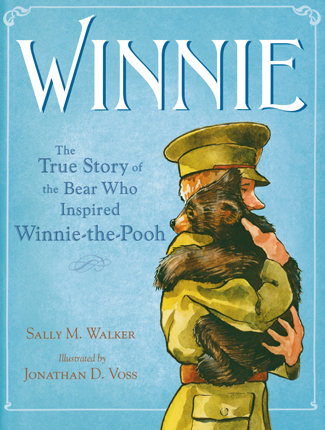Full Text Reviews: School Library Journal - 11/01/2014 Gr 1–2—Readers will be captivated by this picture book account of the bear who inspired the "Winnie-the-Pooh" series. Walker tells the story of Harry Colebourn, a World War I soldier who came upon a man selling a baby bear at a train station (he had shot the cub's mother) and decided to adopt the animal. A veterinarian, Colebourn quickly became attached to the little bear he named Winnie (short for Winnipeg, Manitoba, Colebourn's company's hometown), who accompanied the soldier to a training camp in Quebec and became a favorite of the entire regiment. Winnie even went with the company to England when more soldiers were needed across the Atlantic. When Colebourn was sent into battle, he took Winnie to the London Zoo, where she was so gentle and tame that zookeepers sometimes let children ride on her back. There, Milne's young son, Christopher Robin, met her and fell in love, motivating Milne to pen the "Winnie-the-Pooh" books. Sweet, realistic illustrations, rendered in watercolor with pen and ink, lend the work an old-fashioned air, while a simple but gentle narrative provides readers with a sense of the emotional connection between Winnie and Colebourn. Back matter offers brief material on Colebourn, Winnie, black bears in general, and Milne's writings, as well as photographs of Winnie and Christopher Robin. Children will enjoy this interesting insight into the real story behind a beloved bear they already know so well.—April Sanders, Spring Hill College, Mobile, AL - Copyright 2014 Publishers Weekly, Library Journal and/or School Library Journal used with permission. Booklist - 12/01/2014 Talk about a chance encounter. Harry Colebourn of the Canadian Army Veterinary Corps happened to notice a man sitting at a train stop with a six-month-old bear. Curious, he accepted the man’s $20 offer to buy the orphaned animal, and before Harry’s train trip was over, he’d named it Winnie. As Harry continued his work of training war horses, Winnie followed him everywhere, nuzzling horses and crawling inside Harry’s clothes to play “hide-and-seek biscuits.” When time came to ship out to England, Winnie came, too, and marched with the soldiers at their camp. It was only when the troops were sent to the battlefield that Harry turned Winnie over to the London Zoo, where she became famous for her gentle nature. This story is so intrinsically appealing and delightful that the final act comes as a bonus surprise: author A. A. Milne saw the bear and was inspired to create Winnie-the-Pooh. Beautifully illustrated with humanistic, old-fashioned washes, Walker’s true tale is a low-key heart warmer about an unexpected interspecies bond. - Copyright 2014 Booklist. Bulletin for the Center... - 03/01/2015 Most kids have heard of Winnie-the-Pooh but far fewer have heard of Winnie, a real black bear at the London Zoo, who inspired Christopher Robin Milne to rename his stuffed bear “Winnie-the-Pooh” and his father, A. A. Milne, to chronicle Pooh’s imaginary adventures. Walker sets out to fill this gap for kids, pithily describing how Harry Colebourn, a veterinarian in the Canadian Armed Services during World War I, purchased the American black bear as a cub, named the bear Winnipeg (later shortened to “Winnie”) after his regiment’s hometown, and took the animal with him to Britain on his way to war. When Colebourn was called to France he wisely left Winnie behind at the London Zoo, where she became a popular zoo attraction due to her gentle friendliness and, after Milne wrote about her stuffed namesake, her connection to the Pooh books. This is an intriguing and well-written look at a different era of wild animal care, and some kids may mourn the days when exotic pets were widely legal and zoo visitors were allowed close contact with the animals, even while they acknowledge that such treatment may not have been in the animals’ best interest. The real-life connection to Milne’s Winnie-the-Pooh will draw kids into the history of the book, and photographs of Winnie, Colebourn, and the Milnes on the endpapers will interest youngsters as well. Voss’ watercolor and pen and ink illustrations paint a casual and affectionate portrait of man and bear, and kids will be amused by his depictions of Winnie’s antics. An author’s note offers further information about Colebourn, Winnie and her species, and the Milne connection, and lists of written and internet sources (including a link to vintage zoo video with footage of Winnie) are also included. JH - Copyright 2015 The Board of Trustees of the University of Illinois. Loading...
|



